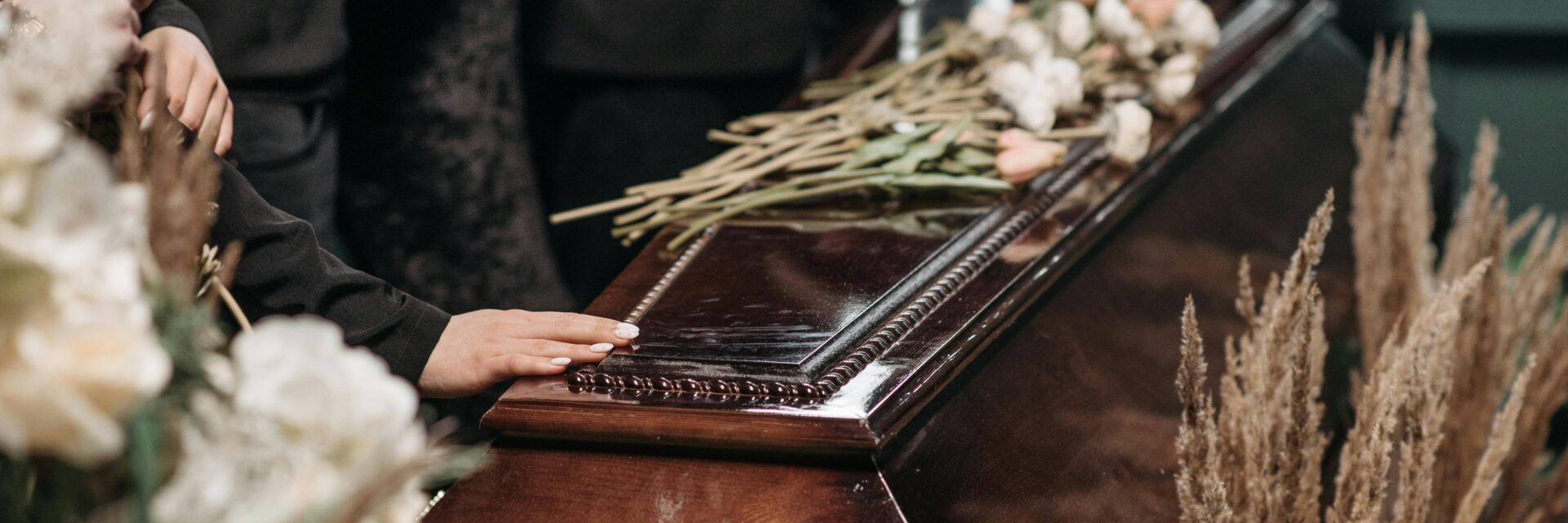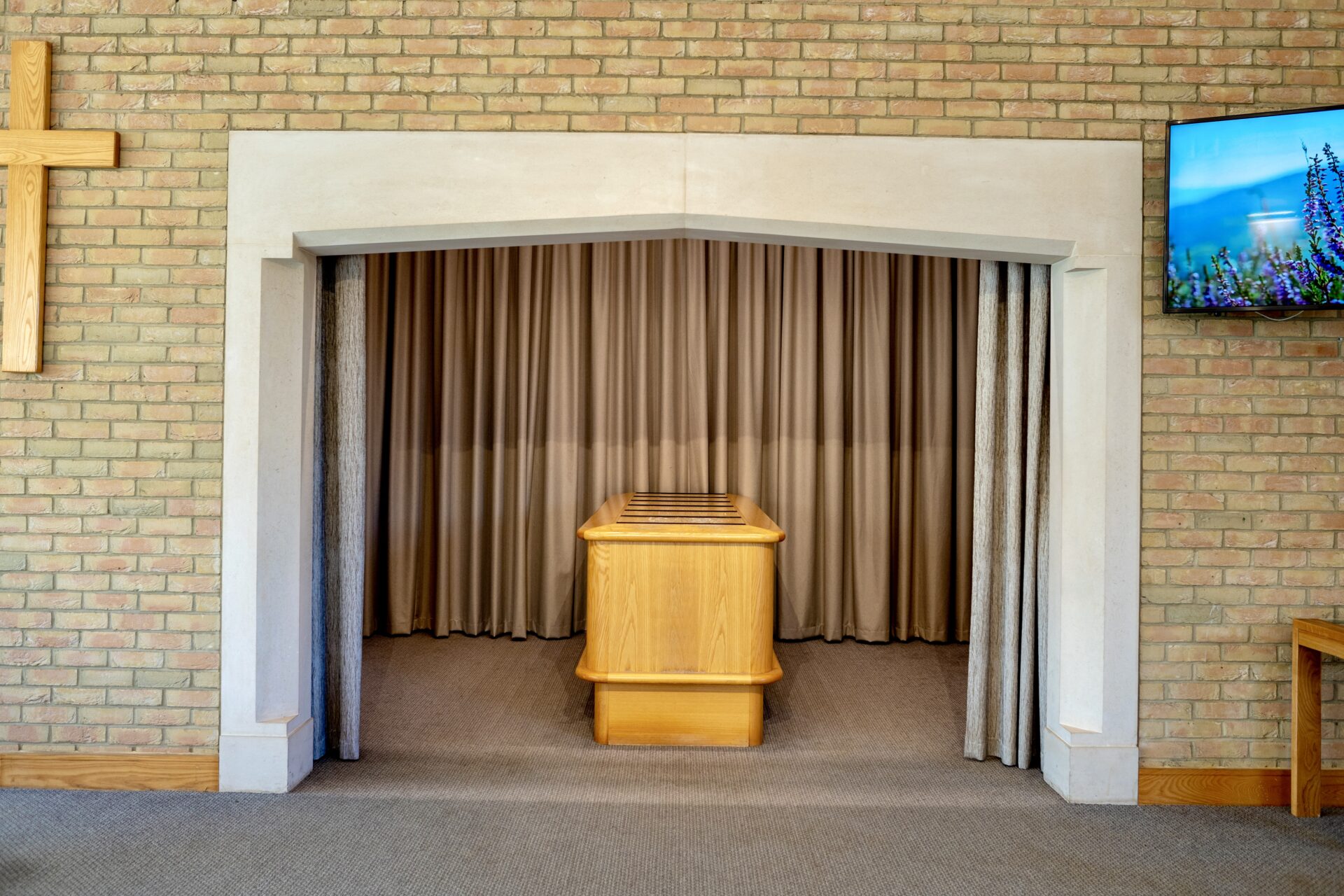
Two Together: Save £100!
Save £100 when you purchase two funeral plans together. Call us for more details.

Here for you this Easter
Our Funeral Plan team is available Friday & Monday, 10am–4pm. Call us for support.

Two Together: Save £100!
Save £100 when you purchase two funeral plans together. Call us for more details.

Here for you this Easter
Our Funeral Plan team is available Friday & Monday, 10am–4pm. Call us for support.

Despite the fact that they’re one of life’s key experiences, we usually only find out what happens at a funeral by attending one in person. We wanted to put together an article that gives some general pointers on what to expect at a funeral, from format to what happens afterwards, as well as some tips on funeral etiquette.

What happens at a funeral ceremony will largely depend on what kind of funeral it is, and upon the preferences of the person who has died. If it’s a direct cremation or a burial at a public health funeral, there might not even be any attendees. And even if it is attended, the format of a burial is very different to that of a cremation ceremony. With the decline of religion in the UK, religious funerals are increasingly rare now, but it can also make a big impact on the content of the ceremony. With all this being said about the variety in funerals, there are some common threads that run through the experience of a funeral in the UK.
It’s fair to expect that, however it’s being organised, a funeral is bound to be a deeply sad and solemn affair. We all want to remember and celebrate the life of the person who has died, thinking of them fondly, but it’s unrealistic to expect the day to feel positive or happy. Depending on the age, personality and former profession of the person who has died, you might meet many different people from all aspects of their life, such as neighbours, close family members, school friends and colleagues.
Strangely, even if you were close to the person who has died, a funeral or celebration of life can show you previously unknown aspects of their life or character, and can leave you with a deeper understanding of who they were. They can help you get to know the one you’ve just lost even better than you already did.
For as long human beings have been dying, they’ve been having funerals. For those who are religious, a funeral is, at least in part, about sending the soul of the dead person on its way into what awaits beyond. But the need to remember and reflect on the lives of those close to us who we’ve lost seems to be a universal fact about death, regardless of whether or not we have faith in a god. A funeral ceremony gives us the comforting opportunity to have closure on our loss, and move forward with the rest of our own lives with a sense of purpose and clarity.
There’s a wide range of formats and structures for a funeral, including whether or not there will be guests present, music playing, floral tributes to the person who has died, or a religious theme.
Attended
At larger attended services, the immediate family will sit closest to the front, making them the nearest to the catafalque (where the casket containing the person who has died tends to be placed). The remaining guests usually sit behind them in order of how closely they know the family or knew the person who died. At a traditional ceremony, pallbearers will bring the coffin into the church, funeral parlour, or crematorium chapel from the hearse and set it on the catafalque in front of everyone.
There will normally be some words honouring the one who has died, known as a eulogy. It can be delivered either by a secular celebrant or a religious minister, depending on their wishes, or even by members of their family. There’s nothing to say that multiple people can’t speak at a funeral; it just depends on the wishes of the family. A eulogy normally encompasses some anecdotes about the person who has died, which are supplied by their wider family and friends, as well as some of their achievements and positive qualities.
After the ceremony, the immediate family will often line up by the exit of the funeral venue, allowing each attendee to filter past them, shaking hands or embracing, and offering condolences.
At a smaller, more intimate farewell, the ceremony will be shorter, and there will be fewer people in attendance, but many of the same themes will run throughout.
Unattended
At an Aura direct cremation ceremony without any attendees, the person who has died will be prepared for their cremation at one of our state-of-the-art care centres. Safely in their coffin, they’ll be brought in a private ambulance to the crematorium, and borne into the chapel before being placed on the catafalque. Music dear to the person in life can be played as they are brought in. An attendant at the crematorium will speak a few respectful words, and then the cremation will shortly follow. Likewise, if the funeral is a public-health funeral (or ‘pauper’s funeral’), it’s likely that it will happen without any attendees, and it could either be a burial or a cremation.
Music often stitches together a funeral ceremony, perhaps playing as the attendees enter the space where it’s being held, and then marking the committal (if it’s a cremation) just before the end of the cremation process. If the ceremony is Christian, there will be breaks in the readings to allow for the singing of appropriate hymns chosen by the family. In general, the kind, frequency, and order of the music at a modern funeral ceremony is entirely up to the family.
Naturally, if the funeral is religious, it will proceed with all of the relevant rites as led by the priest. This would include hymns and specific prayers, too. Traditional British funerals often have certain extras that go as standard, such as hearses, limousines for a funeral procession, floral tributes and pallbearers. Depending on what kind of funeral you’re attending, you may see any and all of these things too.
With the establishment of direct cremation in the UK as a popular alternative to traditional funerals, people are looking for more personal and creative ways to commemorate their loved ones, and to use their ashes at memorial ceremonies.
Once the ceremony is over, the cremation itself is completed within 1-to-3 hours depending on the size of the body. They burn the coffin at the cremation too, before extracting the ashes from the cremator with a rake once cool enough to do so. The ashes are then usually placed inside an urn or a scatter tube of some kind, allowing the family to keep them at home, or scatter them somewhere special to the person who has died. Within 21 days of an Aura direct cremation, we can either hand-deliver the ashes to the family at home, or scatter them at the crematorium’s own Garden of Remembrance.
A direct cremation allows the family to arrange for the practical matters of the funeral to be taken care of (i.e., for the person who has died to be cremated with minimal fuss and expense). Then, following this, at a time that feels best to them, they can arrange a celebration of life for the person who has died once those closest to them are in a better state of mind.
A celebration of life can be a much more personal affair that is designed around the life, hobbies, personality, passions and career of the person who has died. There can be a large gap between the initial funeral itself (along with the shock of losing them), and the life celebration. They often actively involve the ashes of the person who has died, as families can come together specifically to scatter them, or to divide them up so that each family member can either scatter them in their own time, keep them at home, or use them to design a keep-sake. There are all kinds of creative cremation ashes ideas these days, from urns, to jewellery, to ornaments and even cremation ink tattoos. In fact, making sure that the celebration of life afterwards does you justice is a big reason why you might want to plan your own funeral.
There are certain other elements that may or may not be included as part of a funeral service, such as a wake.
A wake – traditionally something that used to happen before a funeral, but which now normally happens afterwards – is something that comes to the UK from Irish funeral customs. Compared to the rigidity of a traditional funeral, the wake was an informal opportunity for the local community, family and friends to pay their respects to (and view) a person who had died, by visiting them at their home. Funerals tended to happen more quickly in the past, which meant that it would be more common for the person who had died to remain at home between the time of their death, and their burial or cremation.
Usually, at a wake, the family would have food and drinks for anyone coming to pay their respects, and there could be singing and storytelling; unlike a traditional funeral, which might last for an hour at most, a wake could go on long into the night (hence the name). These days, a wake is typically seen as a catered event immediately after the funeral ceremony, and is normally held at a nearby hotel or pub. It provides those who’ve attended the funeral with an opportunity to talk about the death, the person they’ve lost, condole with the family, and to reminisce. They can be quite an expensive ‘avoidable’ cremation cost, with SunLife putting the average wake cost in the UK in 2024 at £476.
Funerals can generate a lot of social anxiety; when dealing with something as serious as the death of someone’s loved one, the potential to offend or to make a faux-pas feels like it’s even higher than it would be in normal circumstances. From dress code to whether or not you should bring children to a funeral, there are some important things to know as a funeral attendee.
Funeral etiquette in the UK has deep roots in British history, but is evolving as years go by. In order to avoid any potential embarrassment around how you should dress, make sure to find out beforehand from the family if it isn’t already clear from the invitation. It’s not a given anymore that solemn, mourning attire (i.e., black clothing) will be requested by the family. In fact, more and more often these days people want brightly coloured clothing at their funerals. If you were to mix these up and look the odd one out, it’s not only likely to cause you embarrassment, it may also upset the family.
You should also remain attentive, with your phone switched off throughout.
Don’t be afraid to let your emotions show; the friends and family of the one who has died will appreciate your openness and empathy. But, if you can, try to bear in mind the appropriate level of emotion for how well you knew the person who has died. If you were a new colleague of theirs, you’ll be experiencing a different level of pain than you would be if they were your husband. It’s also important to express condolences at the appropriate time with their immediate family.
Another matter that can provoke funeral-related anxiety is whether or not to bring your children to the ceremony. The golden rule is, if you’re unsure, ask the family. It may, alongside dress-code, be specified whether children are welcome, as you might see on a wedding invitation, for example.
If you are bringing your young children to a funeral, and they’re old enough to understand what’s happening, it’s best to explain to them beforehand in language that they’ll comprehend what they’ll be likely to see. Children are more capable of processing difficult scenarios and emotions than we tend to think, but they are more likely to ask practical questions that adults probably wouldn’t. Just as when you might be breaking bad news to a child, if they ask you questions such as ‘what is inside a coffin?’ or ‘what happens to a body when it gets cremated?’, it’s important not to shame them for being curious; it’s an important part of how they are navigating the world, and if you can be open and honest with them, it will help them to more intelligently handle such situations in the future.
If your child is a baby that is liable to cry at random, again, check with the family whether they’re comfortable with you bringing them along. If they are, and your baby does start to cry during the ceremony, it might be a good idea to leave the room as quickly as possible so that you can calm them down away from the other mourners, and so that they’re not distracted from their own grief. Always remember that the wishes of the family, and the comfort of your child, are the most important things.
Naturally, humanity marks the passing of someone from life into death in an almost limitless number of ways. We have largely been bearing a British format in mind as we’ve written this article, but if you’re going to a funeral that is rooted in a different culture, there could be a whole range of different things that you’ll experience.
Whilst, traditionally, funerals from the West are solemn and formal affairs, that is certainly not the norm the world over. Africa is renowned for its uniquely positive funeral tendencies, from the tradition of dancing pallbearers (sometimes with a large parade of people in tow), to having the dead person at their house for a party that can sometimes last for days on end. In Madagascar, sometimes those who’ve died are exhumed every few years so that they can be at a party in their honour and have their shrouding renewed.
Meanwhile, in China, there is a longstanding practice to pay mourners (“wailers”) to attend funeral services. The more wailing there is and the louder and more emotive the mourning, the implication is that the person who has died is more sorely missed and more important.
Whilst, according to a recent survey by the Funeral Guide, only 17% of funerals in the UK are actively religious in format, it helps to bear in mind that the format of a funeral can differ widely based on its religious or spiritual content. Depending on where you are attending a funeral, and the faith of the one who has died, you may be in for a widely varying experience from what you’re used to.
Different religions have evolved all kinds of different ways of processing death. If you find that you need to attend a funeral that is out of keeping with what you’re used to, the important thing is to keep an open mind, and to ask for guidance if you are confused.
We hope that this article has been of use to you. If you have any questions whatsoever about what happens at a funeral, then you’re more than welcome to reach out to us. Furthermore, if you’re currently looking to organise a direct cremation funeral at short notice, or if you’re interested in securing your future with a prepaid funeral plan, then our team is always on hand to help. You can call us directly, or request a quote on our website.